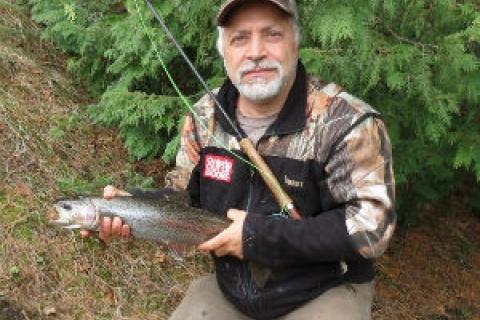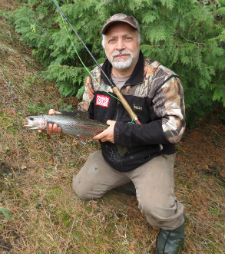
 A friend and I spent time on a small, rough and tumble creek fishing for rainbow trout one morning into the afternoon. Between us we caught sevent nice rainbows measuring between 18 and 26 inches. All but the 18-incher was over 20 inches.
A friend and I spent time on a small, rough and tumble creek fishing for rainbow trout one morning into the afternoon. Between us we caught sevent nice rainbows measuring between 18 and 26 inches. All but the 18-incher was over 20 inches.
What was interesting about this was that only two of nine hook ups were a result of larger streamers or nymphs. The remainder was hooked on flies that were what non-fly anglers would consider ridiculously tiny — size 12 and 14s for the most part — and in very fast water to boot.
As most fly anglers can attest, these look tiny in the mouth of a trout over 20 inches. But that's what it took to catch fish today.
We initially tried hitting these big fish with big flies but the results were less than stellar. And since the only hatch that was coming off were tiny midges, we started cycling through the smaller flies (though not midge-sized, which are even tinier) in our boxes until we found that black micro-wooly buggers seemed to ring the dinner bell — and when that stopped working, tiny freshwater shrimp patterns did.
Though it seemed haphazard, our fly selections were based on past experience, environmental conditions and a bit of logic. The small black micro-buggers looked like the tiny stone fly nymphs that are common in waters like this one. The shrimp pattern, as my friend deduced, is something that's commonly found in waters behind dams, which was where our creek was located. Both worked well.
One of the other challenges we faced was getting a fly down to tick off bottom where the fish were holding. My friend solved it quite successfully by expertly using a center-pin reel and float fishing gear. He caught six of the seven fish.
I was using a fly rod, however, and caught one (a 22-incher) and lost one by swinging these tiny flies in the current and mending line as best I could. I missed a few strikes too and had I capitalized on those, my catch would have been more respectable. I was still happy, as the fishing was tough.
Swinging a fly is a technique that essentially provides a natural arc-like drift down and across the current. If you mend by flipping the line (between you and the fly leader) upstream, the fly will not be dragged unnaturally by current and will sink further (especially if the leader is judiciously weighted with split-shot.
A good swing takes the fly, bouncing off bottom, past boulders, foam lines and other fish-holding cover. Combined with the right fly, it can be deadly.
But the perfect swing takes some fiddling. Too much split shot and you hang up on bottom or drift unnaturally. Too little and those fish on bottom might never see that fly whizzing by so high in the water column.
So to get that perfect drift, you experiment with everything (where you stand, where to initially cast, how much split shot to add, when to mend, how high to hold your rod, how long your leader etc.) until you get it right. And then on the next swing, you might just feel the tap-tap of a good fish taking your meager offering.
It's a great feeling, and once that happens, all you can think of when you get home is about how you'll do it next time.
- 1940 views

